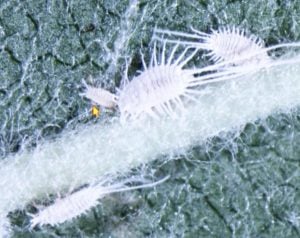Are you prepared for mealybug this season? Has your control strategy been working, or are there important gaps to address? When planning your next steps have you considered the pest pressure in the previous year, and any form of overwintering controls that were implemented.
Mealybug Quick Facts:
- Longtailed mealybugs overwinter as late instar nymphs and adults under bark on the trunk and limbs. Obscure mealybugs overwinter under bark but also on the roots
- If spraying is required for mealybug, it should be timed for when most of the 1st instar (crawlers) have departed from their shelters under the bark and 2nd instar nymphs are apparent on the leaves and limbs. This is the time that the bulk of the population is vulnerable to pesticides. Spraying before then is a waste of time, money, and pesticide.
- Biological control agents are effective at controlling mealybugs if they are allowed to survive pesticide applications in the orchard. Several species of naturally occurring biocontrol agents exist and some are also available from commercial suppliers who can advise on release rates and chemicals to avoid.
- Effective scouting for mealybugs involves a multi-technique approach utilising artificial shelter bands as monitoring traps as part of the trapping run for other pests, checking for crawlers on leaves during mite sampling, looking for honeydew and sooty mould on leaves, limbs and fruit while conducting timed inspections of trees for diseases and other pests, and checking the calyx and stem ends of fruit during damage assessments.

Mealybug (Photo: D Williams, Agriculture Victoria).
Management:
Mealybugs prefer shaded conditions and higher humidity, which means that they are suited to orchards under netting.
Pruning to allow more open canopies that provide better air movement and improve spray penetration may help with control.
The narrow window in which mealybugs are in exposed conditions makes timing of sprays critical. Good timing relies on good monitoring.
Choice of pesticide is also critical because of potential interaction with control of other pests, resistance management considerations, and off-target impacts on beneficial species
Further Information
For detailed information on Monitoring and Biocontrol refer to pages 236-237 of the IPDM Manual: https://extensionaus.com.au/ozapplepearipdm/wp-content/uploads/sites/15/2021/04/2020-final-accepted-version-Apple-and-Pear-IPDM_V3.pdf
See also our video on mealybug identification, monitoring and control: https://extensionaus.com.au/ozapplepearipdm/mealybug-identification-monitoring-and-control-by-natural-predators/
Article reviewed by Greg Lefoe (Agriculture Victoria)
